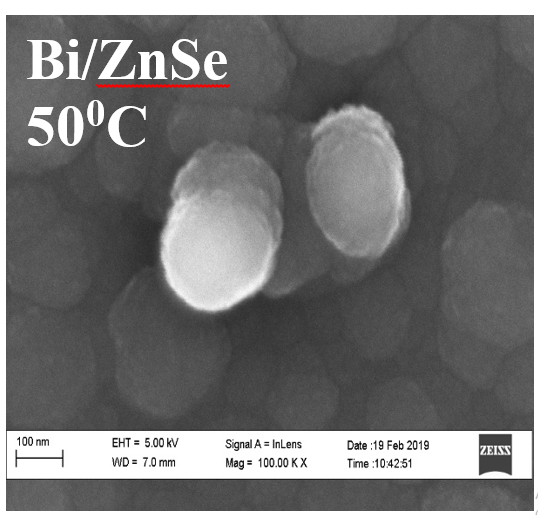Influence of Precursor Temperature on Bi Doped ZnSe Material via Electrochemical Deposition Technique for Photovoltaic Application
Keywords:
ZnSe, Doping, Precursor temperature, Photovoltanic, Electrochemical depositionAbstract
In this study, Bismuth (Bi) doped ZnSe thin films were deposited on conducting glass substrates by electrochemical deposition technique and the influence of precursor temperature (room, 50, 55, 60 oC) on their optical and structural properties were systematically studied using the combined effect of X-Ray Diffraction (XRD), Scanning Electron Microscope (SEM) and UV-VIS spectrophotometer. The XRD patterns show a face-centred cubic structure indexed with peaks at (220), (221) and (300). The grain size was in the range of 3.24056 to 4.60481 nm with a lattice constant of 7.189Å. The material deposited at room, 500C, 550C, and 600C reveals agglomeration of particle on the surface of the substrate indicating uniform deposition. The optical spectra show that at different temperature (say room, 50oC, 55oC and 60oC), the absorbance and reflectance of BiZnSe thin films decreases with increase in wavelength of the incident radiation while the transmittance shows direct proportionality with the increase in wavelength. The bandgap demonstrated an increase in the range 1.75-2.25 eV with increase in temperature.

Published
How to Cite
Issue
Section
Copyright (c) 2022 Journal of the Nigerian Society of Physical Sciences

This work is licensed under a Creative Commons Attribution 4.0 International License.
How to Cite
Most read articles by the same author(s)
- C. O. Lawani , G. J. Ibeha, Olumide Ige, D. Eli, J. O. Emmanuel, A. J. Ukwenya, P. O. Oyedare, Numerical Simulation of Copper Indium Gallium Diselenide Solar Cells Using One Dimensional SCAPS Software , Journal of the Nigerian Society of Physical Sciences: Volume 3, Issue 2, May 2021
- Sherifdeen O. Bolarinwa, Eli Danladi, Andrew Ichoja, Muhammad Y. Onimisia, Christopher U. Achem, Synergistic Study of Reduced Graphene Oxide as Interfacial Buffer Layer in HTL-free Perovskite Solar Cells with Carbon Electrode , Journal of the Nigerian Society of Physical Sciences: Volume 4, Issue 3, August 2022
- Eli Danladi, Jamila Tasiu, Lucky Endas, Preparation and Characterization of High Performance Dye Sensitized Solar Cells with Silver Nanoparticles in nanocomposite Photoanode , Journal of the Nigerian Society of Physical Sciences: Volume 2, Issue 1, February 2020
- Eli Danladi, M. Y. Onimisi, S. Garba, R. U. Ugbe, J. A. Owolabi, O. O. Ige, G. J. Ibeh, A. O. Muhammed, Corrigendum to "Simulation and Optimization of Lead-Based Perovskite Solar Cells with Cuprous Oxide as a P-type Inorganic Layer [J. Nig. Soc. Phys. Sci. 1 (2019) 72–81, https://doi.org/10.46481/jnsps.2019.13]" , Journal of the Nigerian Society of Physical Sciences: Volume 3, Issue 3, August 2021
- C. O. Lawani, G. J. Ibeh, O. O. Ige, Eli Danladi, J. O. Emmanuel, A. J. Ukwenya, P. O. Oyedare, Corrigendum to "Numerical Simulation of Copper Indium Gallium Diselenide Solar Cells Using One Dimensional SCAPS Software [J. Nig. Soc. Phys. Sci. 3 (2021) 48–58, https://doi.org/10.46481/jnsps.2021.133]" , Journal of the Nigerian Society of Physical Sciences: Volume 3, Issue 3, August 2021







